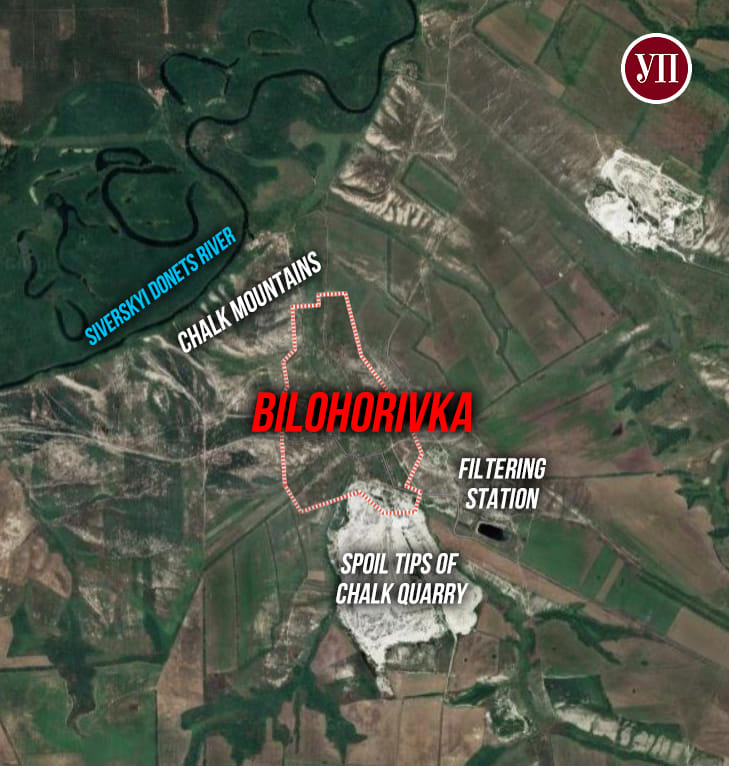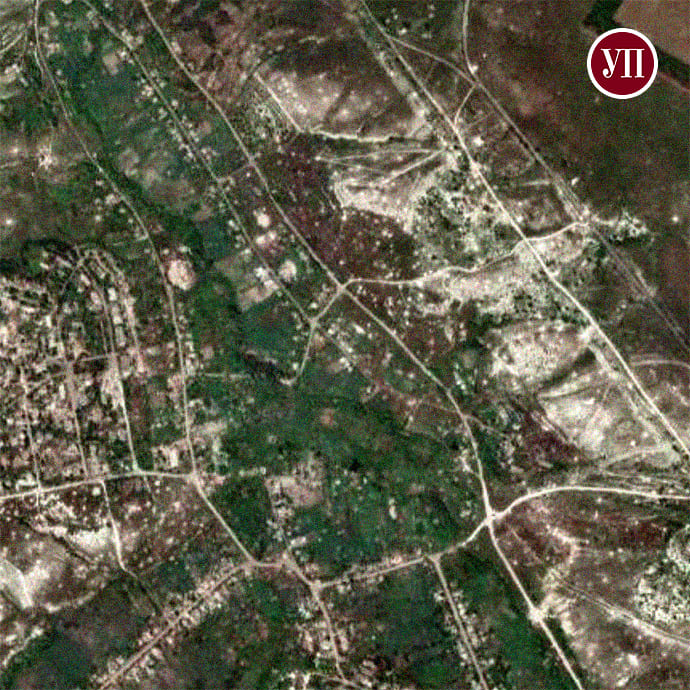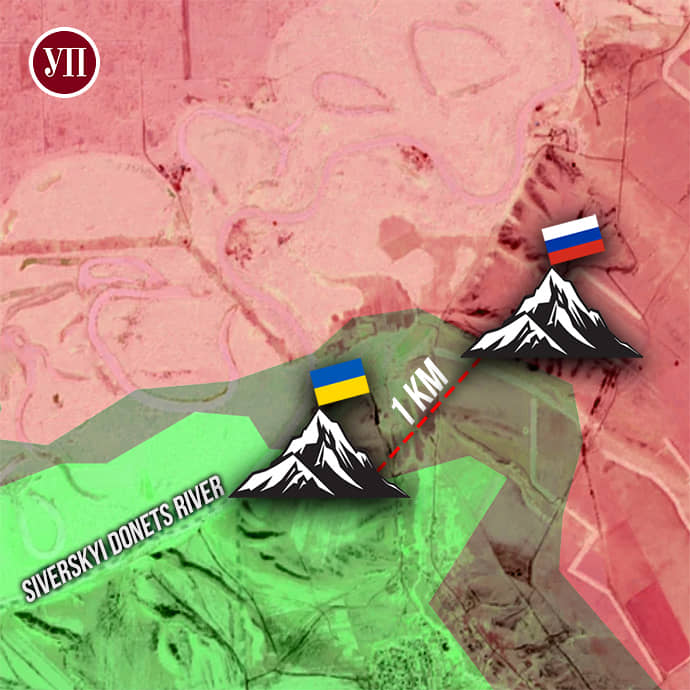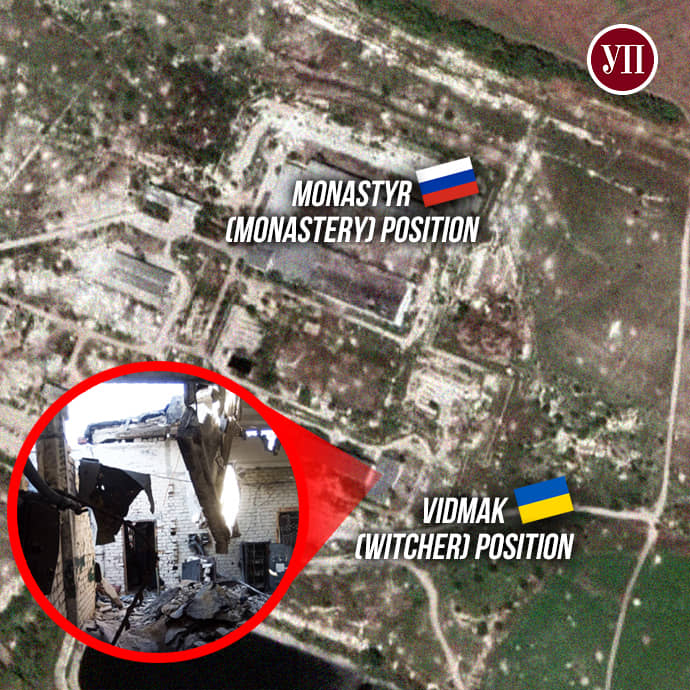The battle for the white hills. What's really happening in Bilohorivka, which hardly ever makes the news
In memory of Bond, a 23-year-old company commander of the 81st Brigade who was killed in Bilohorivka on 13 June 2023. Who loved to "make war" and drink Non Stop energy drinks, and for whom grown men cried. "Why doesn't anyone talk about what's happening in Bilohorivka?" Chornyi (Black) asks Ukrainska Pravda. Chornyi is a 25-year-old machine gunner from the 81st Brigade.
A month ago, as he ran between positions in Bilohorivka, he was wounded for the sixth time since the beginning of the full-scale war. The Russians dropped a munition from a drone above him. Chornyi is convinced that he only survived because he did not stop - that if he had fallen, the Russians would have deployed a second drone and finished him off.
Advertisement:"There are constant assaults there.
There have been so many losses, both on our side and on theirs. There are very few combatants left," he adds. Chornyi isn't overly concerned about the lack of news coverage on Bilohorivka.
His main worry is that because of his injury, he might not be able to get back to the village by 24 August [Ukraine's Independence Day - ed.] and will miss the "festive fireworks" - firefights between the two armies' positions that often break out during holidays. If one can call war a job, then Chornyi is someone who loves his line of work. Just as his comrade Bond, to whom this article is dedicated, loved it.
In investigating the story of Bilohorivka, UP talked to a dozen people whose love and many months of endurance have saved the settlement from probable obliteration. Almost two years after its liberation, despite intense Russian assaults and a dire shortage of men and artillery, the entire village remains under the control of the Ukrainian Defence Forces. Read this article to find out what Bilohorivka looked like before 24 February 2022, what happened in the village after its liberation, accounts of the battles for its water filtration station, and what the main task of this tiny settlement is.
Names and aliases marked with asterisks have been changed at the request of the interviewees.
Advertisement:A village of hills, chalk, and zero inhabitants
Before Russia's full-scale invasion of Ukraine, Bilohorivka was a little-known village home to 700-800 people, and one of the oldest settlements in Luhansk Oblast (it was founded in the early 18th century). Its nearest neighbouring towns are Siversk and Lysychansk. The Siverskyi Donets River flows north of Bilohorivka, while to the west it is flanked by 100-metre-high natural chalk hills from which the village's name is derived [Bilohorivka in Ukrainian comes from "bili hory", which translates into English as "white hills" - ed].
To the south, there is a large chalk quarry which, until 2010, was used to produce chalk for the Lysychansk Soda Plant.

Chalk is synonymous with the word Bilohorivka. It's found everywhere in the village - in the hills, quarries, and even under the gardens left untended in the spring of 2022. During Russia's full-scale invasion, the chalk deposits were clearly visible in the craters left by explosive ammunition - unlike in other settlements, they were white, not black.

The infrastructure in Bilohorivka included a school, a kindergarten, several shops, and a powerful water filtration station, local resident Nadiia*, who worked there for almost 30 years, tells Ukrainska Pravda.
The station purified water pumped from the Siverskyi Donets and supplied it to a third of Luhansk Oblast. Interestingly, before the full-scale invasion, most of the water was supplied to the Russian-occupied territory of Luhansk Oblast - to Pervomaisk, Holubivka, Kadiivka, Alchevsk, Antratsyt, etc. "Due to an order from Kyiv, we had no right to cut off water to Ukrainian citizens in the occupied territories.
There were fellow Ukrainians living there," says Nadiia. "Everything was agreed at the highest level. By the way, we were paid for access to the water supply [by the Russians - UP], paid in cash.
The money was handed over on the bridge [in Shchastia - UP], in a collection vehicle, and then transferred to the state budget," Serhii Haidai, the former head of the Luhansk Oblast State Administration, told Ukrainska Pravda, explaining the specifics of the war until 2022. However, shortly before the full-scale invasion, Nadiia continued, the water supply was suspended (a similar situation occurred in Avdiivka due to shelling). In April 2022, due to the frequent attacks and evacuation of employees, the station stopped operating altogether.
Advertisement:War came to Bilohorivka in the spring of 2022.
In April, the Russians began targeting the village. On 7 May, they dropped a bomb on a local school where civilians were hiding and on 8 May, they set up the first crossing of the Siverskyi Donets River. At that time, the Russians were advancing near Sievierodonetsk and planned to cut off the main supply route to the city - Bakhmut-Lysychansk.
Unfortunately for them, and fortunately for Ukraine's Defence Forces, the Russians chose a route via the tiny town of Bilohorivka. Within days, the Defence Forces - in particular the 26th and 80th Brigades - had destroyed all the crossings, killing almost 500 Russian soldiers and damaging around 80 pieces of their equipment. Thus, Bilohorivka received its month of glory and heroic status as a "second Chornobaivka" [Chornobaivka is a village in Kherson Oblast, Ukraine, where Ukraine's Armed Forces repeatedly destroyed Russian positions and equipment during the full-scale invasion - ed.].
At this point, the inspiring story of the battle for Bilohorivka pretty much came to an end, at least as far as the media were concerned. Here and there, one can find scraps of information about the occupation of the village in July 2022 and its rapid liberation in September of the same year. There are also just a few videos from the village itself in circulation, taken by the military.
What happened next? When volunteer Yevhen Tkachov, whose work is often covered by Ukrainska Pravda, visited Bilohorivka in the first few weeks after the liberation, he found only 15 local residents. Some of them eventually moved to territory controlled by Ukraine, especially the neighbouring village of Serebrianka.
Some chose to live under Russian occupation and went to Lysychansk. Around the same time as Marinka, in the autumn of 2022, Bilohorivka became a settlement with a "zero inhabitants" status... but with several hundred tenants - soldiers of the Burevii Brigade of the National Guard and the 81st Airborne Brigade of the Armed Forces of Ukraine - occupying the local basements.
Landing on the chalk hills
The 81st Separate Airmobile Slobozhanska Brigade of the Air Assault Forces was the main unit defending Bilohorivka after its liberation from Russian occupation. Bilohorivka was the obvious destination for the 81st, which had liberated settlements on its way to it - Bohorodychne, Sviatohirsk, Sosnove, Lyman, and Oleksandrivka.
Bilohorivka still looked like a settlement in October 2022. Despite the marks of shelling, the streets, houses and fields were clearly defined. The situation looked relatively calm, the brigade having taken over the entire perimeter of the settlement and a large chunk in front of it.
However, in early December 2022, the Wagnerites - mercenaries from the Russian Wagner Group - launched their first major and partially successful assault on Bilohorivka. They practically pelted the Ukrainian infantry with cannon fodder. The 81st managed to regain some of its lost ground a month later, in January 2023, when it successfully took advantage of the Wagnerites' withdrawal.
Almost the entire brigade went on the offensive and advanced a couple of kilometres to the east. "We gained the advantage over the enemy when the Wagnerites left - in intelligence and in weaponry. We could walk around Bilohorivka without fear.
We could come out of the basement and have a coffee while the birds were singing. But the situation is different today. Now we're not up to their level in terms of the number of Mavic and FPV drones, which don't allow our guys to breathe easily," an 81st Brigade fighter known as Teddy tells Ukrainska Pravda.
The Russians launched a new wave of assaults in January 2024. Bilohorivka's current defences have been in place since around April this year. Chornyi tells Ukrainska Pravda that for more than a year, one of the most active battles in Bilohorivka has been over positions between two hills about a kilometre apart.
The western one is controlled by the Defence Forces, the eastern by the Russians. Neither side, despite constant attempts, has been able to significantly shift the line of contact.

Bilohorivka has an important strategic role due to its location and landscape. Its heights make it possible to monitor three fronts at once.
The first front is the Serebrianska Forest along the Siverskyi Donets River, which is defended by the Burevii and Azov National Guard Brigades. The second is the city of Siversk, which is held by the 10th Brigade. Thirdly, the position also allows partial monitoring of the Verkhniokamianske and Spirne fronts, where the 54th Brigade and the Svoboda Battalion are located.
Advertisement:"If they enter Bilohorivka itself, they will find themselves in lowlands and simply hide in the ruins.
If they occupy the part of the village on the slope, they will be able to take fire control of the communication routes for those in the Serebrianka Forest. If they occupy the quarry, Siversk and Verkhniokamianske will be at risk. We absolutely must not let them take the heights," a commander known as Bastion explains to Ukrainska Pravda.
"The next one is Lyman," adds Teddy.

One of the most substantial and harrowing discoveries Ukrainska Pravda made while working on this article was the length of time the 81st Brigade soldiers stayed at their positions in Bilohorivka: from a month to a year without leaving their positions. The reason for this was and remains the extremely difficult logistical challenges. It was also due to the huge shortage of people in the brigade that began to be felt around July 2023 - almost a year before the parliament passed a stricter mobilisation law, which obviously came too late.
One company in the 81st Brigade received four new recruits from July to December 2023. Currently, when the enlistment office sends a batch of recruits to the airborne brigade, the youngest might be 50 years old. It takes from a week to a month to train a new recruit before they go to Bilohorivka, depending on how urgently the positions need people. Bastion shares his thoughts: "We had a position that was held by one injured soldier.
There was a time when two people were repelling an assault by 17. There was a time when there were 13 men at the position instead of 50. Someone who's feeling on edge might say: we need to retreat further!
But I'd say: where to, if everything will be the same, only a few kilometres further in? We retreated from Avdiivka and lost more than 20 settlements." "We're probably the only brigade that hasn't surrendered our settlement yet, and hasn't surrendered any large forest areas.
We're locals here. We know every path. Experience shows that as soon as a new brigade enters an area, and they are mostly newly formed, the loss of territory begins immediately," adds Teddy, explaining that he considers the price that the 81st is paying for Bilohorivka's defence to be justified.
Chornyi talks about "life" in Bilohorivka:
My shortest visit to Bilohorivka lasted three days - I was wounded after that and am now receiving treatment.
The longest one lasted 57 days. We build some of the fortifications in the earth and some in chalk. To build a position in chalk, you either have to plant TNT or spend a long time chiselling with a pickaxe.
The position we have in one place is so deeply set into the hill that even if a KAB [a type of precision guided missile used by Russian forces - ed.] falls on it, nothing will happen to us! But it will make a big bang, throwing 60 metres of earth and chalk above us. I enjoy working in the rain because you don't have drones flying around then.
Of course, you can't dig, but you can carry materials for dugouts. We are constantly making shelters. We had no connection at the position recently, and we had to go to the 'warm bank' to access the internet.
Some people are afraid to move between positions, but I'm more afraid not to call my wife - I walk there twice a day sometimes. Earlier, we could order a chicken directly to the position! We chopped a salad to have with it - chop, chop, chop and a tasty dinner was ready, then we went to bed.
But we can't do that now. By the way, I even took a "bath" in Bilohorivka! I got some water in a bucket, heard that there were no drones, ran out, hooked the bucket, washed my body, rinsed it off and ran back in.
There's a river in Bilohorivka, and a Browning box [a metal ammunition box - UP] is perfect for collecting five litres of water. We can also put it on a small potbelly stove, which we use to put trench candles in - we can't use wood because the smoke would be visible - and heat [the water] up. What are the worst days for us?
When Russians get into the trenches. Once, we weren't paying enough attention, and the bird [drone - UP] wasn't that attentive either, so the f**kers ran into our trench and threw a grenade into the dugout! I was sleeping at the time, and my boots were drying outside.
I ran out, with one foot wearing a slipper and another a sock, and the action had already begun - some people were shooting from the shelter, some were throwing grenades. And only one boot was left! Then they shouted to us: "Surrender, and we'll let you all live!" I replied: "If you give me back my boot, you prick, then maybe I'll let you live!" He threw a grenade at me, but it flew right over.
I had an American grenade, though! I said: "I have a better one - eat this!" It f**ked him right up, and the rest just fled. Afterwards we were made to carry him out for a PoW exchange.
Along with my boot they stole a machine gun that we'd taken from them earlier.

Battles for the filtering station
Prior to the full-scale war, the Bilohorivka industrial zone was known as the Western filtering station's second water intake. The station remained mostly intact after the occupation and liberation of Bilohorivka. In April 2023, it became a hot spot for small-arms shootouts.
After a series of intensive assaults, the Russians broke through into the industrial zone and took the largest three-storey, U-shaped building, known as the Monastery position. They knew the industrial zone was at the "junction" of two brigades, the 81st in the north and the 54th in the south, so they planned to strike at what appeared to be the weakest point.
Advertisement:Franz, a scout from the Horiv Battalion of the 1st Burevii Brigade, a civilian not that long ago, was one of those deployed to retake the Monastery position. On 12 May 2023, he came to Bilohorivka, and on 15 May, he embarked on his first combat deployment - straight to the industrial zone.
"Of the eight people who set out to help the boys take back the Monastery position, only two made it: Jordan and me," Franz recounts in a phone call with Ukrainska Pravda. "One was killed on the way, three were critically injured, and the other two had their path blocked by Russian shelling - they were striking us with Solntsepyok [rocket barrage from Russian TOS-1 tanks - ed.] at the time... With us two in position in a little building, now there were 10 of us instead of eight. Though there were about 60 Russians.
Our first fight lasted seven and a half hours, with a short 20-minute break to reload. They were so close, they had already hurled grenades at us over a concrete fence! The combat took place at a distance of 5-7 metres."
As the guys later discovered, in order to get so close to their positions without being noticed, the Russians had proceeded down a one-and-a-half-metre-wide pipe that had previously been used to drain water. When they emerged, they were about 20-30 metres away from the National Guardsmen's position. After some time, Ukrainian aerial reconnaissance was able to track down the Russians' points of entry and exit from the pipe, which were eventually destroyed by artillery.
For eight months, the same tale with untimely destroyed pipes was repeated in Avdiivka, and it was used to further undermine the Defence Forces.

For objective reasons, the National Guardsmen were unable to drive the Russians out of the industrial zone on 15 May and the subsequent days. For starters, in addition to successfully manoeuvring via the pipes, the Russians were aided by the location of the industrial zone itself, which was situated entirely in the lowland and therefore easily visible. Secondly, the Russians occupied a U-shaped building with solid walls and multiple underground levels that had withstood two Himars strikes.
It's quite tough to storm such a building. Thirdly, as was typical at the time, the Defence Forces lacked fighters and artillery. In one week, the National Guardsmen had to maintain the defence of the area with 24 people. The industrial zone covers an area of around 25 hectares, which is equivalent to five times the area of Kyiv's Shevchenko Park.
The Russians demolished the little building where Franz was holding the defence (the Witcher's position) with artillery. He attempted to count the number of Russian shells that flew at them and lost count on the 226th. After a while only three of the building's six rooms were left , each with a maximum capacity of six people.
"And we heard from the intercepts that the Russians thought there were 20-25 of us!" Franz recounts. After one month, only 24 out of the 100 people from his unit who had gone to defend the industrial zone were still combat-ready: 8 scouts and 16 infantrymen. The majority had survived, but they had been injured by shelling and evacuated.
According to Franz's observations, the Defence Forces and the Russians had a loss ratio of about 1:5 to 1:8.
Advertisement:The last of the half-destroyed buildings, the Witcher's position, was occupied by Khamer's group. Khamer, 30, was Franz's brother-in-arms, with whom he had gone through training and baptism by fire. On that day, 5 June 2023, the Russians attacked the six National Guardsmen with approximately 40 soldiers.
Unfortunately, only one of the seven mines surrounding the perimeter worked. "Khamer stayed behind to cover the group during their retreat. He let everyone retreat, but stayed himself.
He ran literally 15 metres [from the Witcher's position - ed.], knelt down, reloaded, and began shooting back. He is reported missing. All his boys came out as 'Cargo 300' [injured - ed.].
Jordan, who'd come with me to the industrial zone on 15 May, walked for several kilometres to the Casevac with broken legs and punctured lungs," Franz shares. Around 20 June 2023, one of the newly-established battalions of the 81st Brigade replaced the National Guardsmen at the industrial zone. It was unable to take back complete control of the filtering station.
On the contrary, the Russians eventually drove out the Ukrainian paratroopers by demolishing the buildings that could be used as defensive positions with artillery. "Once there was a story that spread through all of the Telegram channels claiming that there were Russians on the ground floor of one of the industrial zone buildings while 13 of our guys were in the basement. From what I've heard, they all got out of there," Teddy told Ukrainska Pravda.
According to the DeepState map, the Defence Forces currently control roughly 20-30% of this territory. According to Ukrainska Pravda's sources in the 81st Brigade, this percentage could be considerably lower. ***
The battle for Bilohorivka continues. The 81st Brigade still needs reinforcements.
By Olha Kyrylenko
Translation: Yelyzaveta Khodatska, Violetta Yurkiv and Theodore Holmes
Editing: Rory Fleming-Stewart